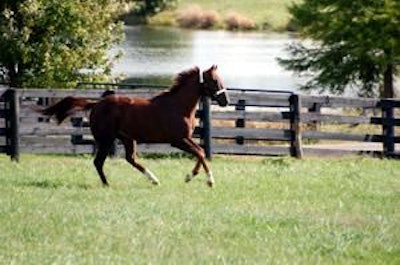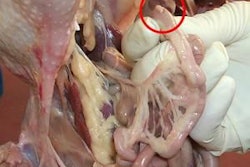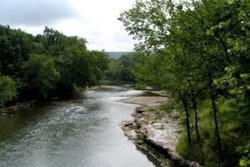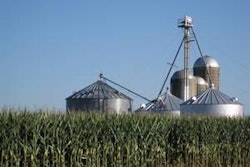
A number of factors have aligned to give horses a longer lifespan. Better nutrition and improved health care are the main reasons horses are living longer although the recent closing of the last U.S. equine slaughterhouses may also be a consideration. No one knows this better than Michael Blowen, owner and founder of Old Friends, a rescue facility for retired racehorses.
Without 401Ks, these superstars of the racing industry often find themselves unwanted and neglected in their senior years. “We’re used to seeing them as racing and breeding animals, but thoroughbreds are very intelligent and many can be retrained for a third career for dressage or recreation,” says Blowen.
Blowen opened Old Friends in 2002 after learning that Ferdinand, winner of the 1986 Kentucky Derby, had been slaughtered in Japan. Today, Old Friends cares for about 70 retired racehorses and the facility has a waiting list. The vast majority of Old Friend’s horses are well into their senior years with an average age at about 25 years. Fortunate Prospect, now 29, the oldest resident at Old Friends, sired 775 foals that went on to win $38 million.
Seniors still impress
Many of the horses at Old Friends arrive in poor condition, although one would never know that now. Performers since birth, these senior horses still love to impress crowds. “They show off for the visitors. Each one has its own act,” notes Blowen. For instance, Kiri’s Clown, 21, and Awad, 20, who faced each other more than once on the track during their racing careers, still go head to head in the paddock. “They race against each other all the time as if they know who the other one is,” Blowen says.
To date, most of the horses at Old Friends have hailed from U.S. stables, but five were imported from Japan. One of the all-time greats, Ogygian, 27, arrived from Japan in 2005. “He was an amazing race horse. He wasn’t in great condition when he arrived, but he looks fabulous now,” says Blowen. “We don’t work miracles. We just feed them.”
A few decades ago, a 20-year-old horse was considered an anomaly. Today an estimated 10 to 15 percent of the 9.2 million horses living in the United States are 20-years-of-age or older. The aging horse population has created a growing market for feed companies.
Growing feed market
“Senior horse feed, in general, is an expanding market, and the additives that accompany special diets are growing as well,” says Steven Elliott, global manager for Alltech’s Sel-Plex and Bioplex products. “Demand for feed additives that help older horses is increasing. It’s a niche that’s here to stay.” Alltech, headquartered in Lexington, Ky., produces a number of additives used worldwide in senior horse feeds as well as nutritional and health supplements for other livestock species of all ages. The company will sponsor the FEI World Equestrian Games in Lexington in 2010.
Knowing just when a horse enters its senior years is not always easy. “Many horses look and act geriatric at 15, in others old age is evident only at 25,” says Dave Spaulding, sales manager with O.H. Kruse, a feed company in Goshen, Calif. Pleasure horses tend to age more gracefully, while performance and work horses often look old before their time. “It’s the same with people,” Spaulding says. “Retired football players that have been beat up during their careers tend to have arthritis by 40, while other people are still running marathons at 50.” You can tell a horse is geriatric by observing its behavior and appearance. “Typically they fall off in terms of energy, performance, and weight,” he adds. Many also have a swayback appearance.
Dr. Marty Adams, equine nutritionist with Southern States, a cooperative based in Richmond, Va., serving 300,000 members, notes that horses are living longer along with our population. He estimates that current average lifespan for a horse in the United States is close to 24. This means that teeth must also maintain function for two to three decades. Not surprisingly, dental problems are common reasons why senior horses often are not benefitting from their diets and are malnourished.
Pellets, cubes assist digestion
A horse with excessively worn molars will no longer be able to chew hay and will have trouble breaking long hay stems into smaller digestible pieces. When horses reach this stage, most will need to rely on formulated feed pellets, hay cubes, or chopped hay. “We don’t just feed hay and oats anymore,” says Spaulding. His company offers two formulations of Perfectly Senior to satisfy seasonal caloric needs.
As horses age, their ability to maintain an even body temperature gradually diminishes. “A significant amount of calories are needed to keep the body warm during the winter months. In summer, older horses hold their weight more easily,” Spaulding says. O.H. Kruse’s winter diet is formulated to supply additional calories. He estimates that in some higher elevations in California caloric needs for older horses in winter increase by 15%.
Throughout the aging process, horses also have greater difficulty maintaining normal bowel function as demonstrated by an increased incidence of colic. Prepared feeds for older horses should contain a higher proportion of highly digestible fiber than conventional horse feeds. “Diets for senior horses can be consumed at higher rates than conventional feeds and are formulated to replace most of the hay or pasture that the horse would normally consume,” says Adams. Sources of digestible fiber include beet pulp, soybean hulls, and alfalfa hay.
Senior horses also need more fat and protein than younger animals. The retired racehorses at Old Friends are fed Triple Crown Senior, a product produced by Southern States. This diet contains 14% protein, 10% fat, and 17% fiber. Diets high in fat and fiber contribute to efficient digestion and hence condition.
Additives include yeast, vitamins
Feed additives also help to maintain health and function. Elliot says that yeast cultures, such as those found in Yea-Sacc, promote digestion of fiber and absorption of phosphorus and magnesium. Most commercial senior horse feeds contain some type of yeast additive in addition to Vitamins A, C, E, and selenium which are required to maintain immune function and integrity of muscles.
While getting an older horse to eat enough can prove challenging, excess feeding of younger horses can cause problems in later years. “We are seeing more and more horses that are being killed with kindness,” says Spaulding. Obese horses are more prone to metabolic dysfunctions similar to type-2 diabetes in people. To help prevent or delay the onset of Equine Cushing’s disease, senior horse feeds should be low in sugar and starch.
Exercise is critical
Exercise is another critical component of senior horse health. “Exercising older horses daily helps them adapt to the onset of arthritis,” says Adams. “It keeps their joints more flexible.” The horses at Old Friends can attest to the importance of exercise as they romp in their paddocks. “We keep them out as much as possible,” says Blowen. “They stay out twenty-four-seven unless they are ill. Our Veterinarian’s philosophy is that every day a horse spends in a stall is a day from its life expectancy.”
With the volumes of material available on the Internet today, horse owners are becoming more familiar with the special needs of older horses. “Today, a vast majority of horses are considered companion species,” Spaulding adds, and most owners of recreational or non-working horses would not consider slaughter as a means of disposal at the end of a useful life. With the last of the U.S. slaughterhouses now closed, slaughtering a performance or workhorse means shipping to Canada or Mexico. The reality is that more horses will require supportive nutrition for their senior years.

















